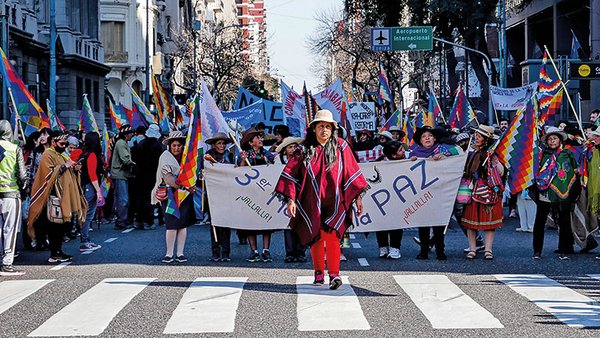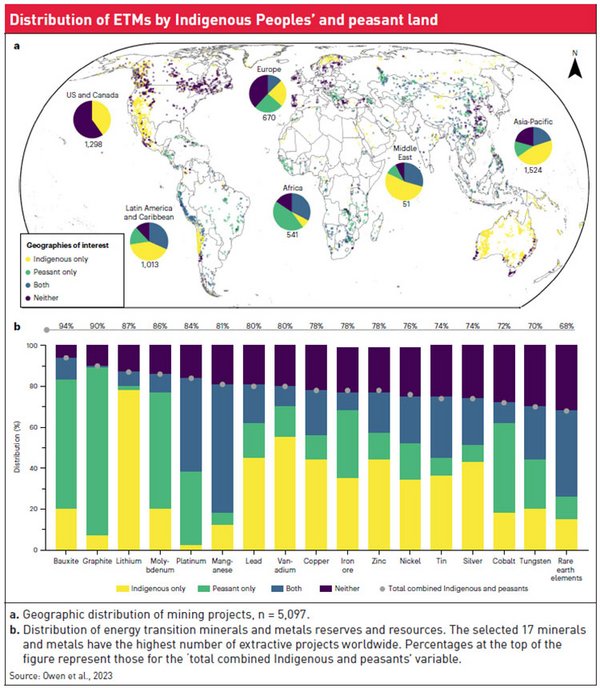 Download this article in magazine layout
Download this article in magazine layout
- Share this article
- Subscribe to our newsletter
Reconciling the green energy transition with the rights of Indigenous Peoples
“Our struggle as Indigenous Peoples is legitimate. We are not asking for anything, only to continue living in peace, as we have for centuries, in harmony with nature and protecting the Pachamama. Today, our lands are seen as ’empty spaces’, because big mining corporations come to our lands to make money, even if it means leaving us without critical natural resources, such as water. And those who supposedly govern for the people allow them without hesitation to do so […]. As Indigenous Peoples we demand the cancellation of the reform that benefits foreign companies to exploit our natural resources leaving only pollution and dispossession! Jallalla ...” (Personal, interview, Mujeres Defensoras del Hábitat Natural, 2023).
This is a statement by women who are defending their territory in the province of Jujuy, in the north of Argentina, which is part of the famous lithium triangle in the large salt plains of Argentina, Bolivia and Chile. Recently, the local government of Jujuy enacted a speedy reform to the provincial constitution, undermining community property rights, limiting the right to protest, and providing enabling conditions for the extraction of strategic resources like lithium, one of the most important energy transition minerals (ETMs).
The reform has since faced significant scrutiny from human rights organisations and Indigenous Peoples, also because it took place without proper debate, participation of Indigenous Peoples, or adherence to the principles of free, prior and informed consent (FPIC). Water resources in the region, as well as the rights and livelihoods of Indigenous Peoples and peasant communities in Jujuy, hang in the balance. The escalating criminalisation of Indigenous Peoples defending their territory is deeply concerning and underscores the government’s bias favouring the extractive mining sector under the guise of promoting the benefits of the energy transition.
In Argentina, home to about 20 per cent of global lithium deposit, lithium exploitation began in the 1980s, but between 2015 and 2020 its production increased by 72.2 per cent. In 2022, the country produced 33.000 tons of lithium, which is equivalent to five per cent of global production, and ranked as the fourth international producer after Australia, Chile and China. According to Argentina’s government, it is estimated that by 2030, the main source of lithium demand world-wide will be lithium-ion batteries, chiefly associated with the increase in the use of electric vehicles and overall demand from the Global North. According to the International Energy Agency (IEA), lithium is expected to see the steepest demand for growth compared to all other energy transition minerals.
The ever-increasing and often scrupulous pursuit of lithium felt by the Indigenous Peoples of Jujuy is not unique to the region but replicated across the globe in areas where ETMs are located. As history is repeating itself in an ongoing cycle of demand for resources, in this case, to fuel a global transition towards net zero economies, those most affected find themselves in conflict against a bulwark of geopolitical forces working against them.

Lithium-ion batteries for electric bikes. The mistakes of the past should not be repeated in procuring the resources for the green enerty transition. Photo: Jörg Böthling
The IEA anticipates a requirement of 48 trillion US dollars in investments by 2035 to fulfil global energy demands. At least half of this sum is earmarked for renewable electricity sources and energy efficiency initiatives, a goal supplemented by the UN Framework Convention on Climate Change COP28 presidency, which called for a tripling of clean energy production by 2030. Despite the crucial need for investments in cleaner energy generation, this transition will incur significant, yet under-recognised, costs due to its land-intensive nature. Green energy production is estimated to be ten times more land-intensive than its fossil fuel equivalent. It is also highly mineral-intensive, driving a growing demand for energy transition minerals such as lithium, cobalt, nickel, copper and others, with many of these commodities subsequently hitting record high prices in the early 2020s.
Estimates vary about the quantity of transition minerals located in Indigenous Peoples’ territories, ranging from more than half of global deposits being located in or near Indigenous Peoples’ lands and territories to nearly 70 per cent. Inevitably, Indigenous Peoples are thus poised to experience the most significant impact from the escalating demand and subsequent increase in land conflicts on the horizon. Socio-environmental conflicts frequently lead to heightened tensions between mining operators and/or governments and the communities entangled in the disputes. Recent analysis by the Land Matrix Initiative shows that the mining sector is already a major driver of large-scale land acquisitions in developing countries, with current transnational mining deals often situated in areas characterised by high land tenure and food insecurity.
The conflict between Indigenous Peoples and the mining industry originates from a fundamental clash over the state’s customary assertion of ownership over subsoil resources, irrespective of whether these areas are inhabited by local communities. This divide sets the stage for a distressingly familiar cycle of conflict reminiscent of fossil fuel extraction, encompassing environmental degradation and habitat disruption, the displacement and resettlement of populations, pollution and its adverse effects on public health, the criminalisation of grassroots movements, pursuit of indigenous, land and environmental defenders, and the influx of foreign workers, bringing with it associated social challenges.
Based on ongoing projects, Owen et al. (2023) mapped the regional hotspots and underlined the considerable pressure on Latin America and Asia Pacific (see Map). Africa, in turn, has the highest number of projects located in peasant land, or land that is characterised as that of both Indigenous Peoples and local communities, with significant global reserves in cobalt, platinum and iridium.
Why do land rights matter?
The stress inflicted by energy transition and increased demand for resources further underline the fundamental importance to protect legitimate tenure rights. Securing the rights of those who live and work on the land is the cornerstone of a just energy transition. Under a business-as-usual scenario regarding land rights, the growing demand in minerals associated with the energy transition will reproduce existing patterns of injustice.
It is key to adopt a human rights-based approach to the mining sector of ETMs, which fully enshrines the UN Declaration on the Rights of Indigenous Peoples. It needs to recognise the importance of land rights as well as ensuring meaningful engagement, equitable benefit sharing and providing fair compensation for any adverse impacts, and establishing transparent mechanisms for resolving conflicts. Ensuring accountability across scales is important, from different layers of responsibility in local/national institutions to operating companies and their shareholders. But thus far, while increasingly targeted guidelines are starting to emerge, they remain mainly voluntary and are characterised by the lack of enforcement, control and sanction mechanisms.
While the demand for mineral commodities is ever increasing, mapping rights of Indigenous Peoples is an urgent step to ensure the inclusion and legitimacy of previously excluded rights-holders. Mapping rights isn’t just a quick fix – it’s part of a bigger attempt to address power imbalances. These efforts focus on the root causes of vulnerability and are part of a larger movement urging us to rethink how we approach social transformation and development models in a just way.
Green energy production is estimated to be ten times more land-intensive than its fossil fuel equivalent.
Recycling, circular economy models and investment to increase material efficiency are also proposed as positive pathways to support the just energy transition. Recycling minerals will be a key component of any calculations towards how to meet the increasing demand for raw materials to fuel the energy transition. But even if by 2040, countries manage to secure supplies of significant shares of selective ETMs such as lithium and copper through recycling secondary minerals, this will still be outmatched by the projected surge in demand. Therefore in the foreseeable future, the initial phase of the value chain (extraction of ETMs) as well as deployment (infrastructure, e.g. in the form of wind farms) will continue to burden developing countries abundant in critical minerals with the social and environmental costs of the energy transition. Within these countries, Indigenous Peoples, such as those impacted by lithium mining in Argentina, are going to bear the brunt of these effects.
Where to from here
With a wealth of experiences across the globe of “how not to do it”, we would appear to be wiser and more equitable today when it comes to reconciling the global demand of resources with the need to protect the most vulnerable on the ground and ensuring that their rights are safeguarded and their interests are protected. The pressure stemming from energy transitions and the rising need for land and resources underscores the critical necessity of safeguarding rightful tenure and honouring the principle of free, prior and informed consent (FPIC).
Ensuring the rights of those living on and from the affected land must form the bedrock of an equitable energy transition. Otherwise, the increasing demand for minerals linked to the energy transition will perpetuate and worsen prevailing injustices. A rights-based strategy on all levels is urgently required in renewable energy governance to adequately tackle the negative human rights impacts and associated risks. This must include the following:
- Clarity on land tenure. Land lies at the centre of ongoing and future conflicts relating to the majority of resource extraction and infrastructure development required for reaching a net zero economy. Those who live on and from the land have to be involved in any decision-making that may affect them. Appropriate legal frameworks, such as the new Customary Land Rights and National Land Commissions Act of Sierra Leone (2022), could serve as examples of the most progressive legal frameworks protecting communities against unwanted mining, including women.
- Full implementation of the right to FPIC. Indeed, a recent report by Oxfam highlights that current company policies within the mining sector regarding ETMs inadequately acknowledge Indigenous Peoples’ right to FPIC. We need to do better than that and follow the best practice standards that have been developed in this field.
- Beyond FPIC, adopting other business procedures that are aligned with the UN Guiding Principles on Business and Human Rights, or more targeted ones, such as the Initiative for Responsible Mining Assurance. This needs to include the introduction of dispute settlement, grievance and redress mechanisms that are available and accessible to Indigenous Peoples.
- Protection of indigenous, land and environmental defenders (ILEDs). In 2020, the NGO Global Witness documented the killing of 227 land and environmental defenders, with over a third of those being indigenous people. The Alliance for Land, Indigenous and Environmental Defenders (ALLIED) further estimated that for every killing, nearly four non-lethal attacks were documented on ILEDs, 83 per cent of these against indigenous people and other community leaders. Between 2010 and 2022, the Business and Human Rights Resource Centre reported 510 allegations of human rights abuses related to energy transition minerals. While we all recognise the importance of phasing out fossil fuels, it is critical for the energy transition to be just as accountable to human rights abuses as all other industries.
- Shared ownership and prosperity models. In addition to accountability mechanisms, FPIC and other safeguards, new development models have emerged over recent years which move beyond due diligence to proposals of co-ownership and co-development. Such models, which exist for both energy production and mining, must be celebrated and mainstreamed. For examples, explore the “Shared Prosperity Hub” co-hosted by the Business and Human Rights Resource Centre and Indigenous Peoples' Rights International.
Nicolás Avellaneda is the Facilitator of the National Land Coalition of Argentina.
Maria José Guerra is Data and Climate Change Programme Officer for the Regional Coordination Unit of the International Land Coalition (ILC) in Latin America and the Caribbean.
Johanna von Braun is Lead, Climate and Nature, Indigenous Peoples for ILC's Secretariat.
Jeremy Bourgoin is Lead, Knowledge and Research, for ILC's Secretariat.
Contact: j.vonbraun@landcoalition.org
References
AIDA. “El agua vale más que el litio”: Resistencia a una transición energética injusta, 2023. https://aida-americas.org/es/blog/el-agua-vale-mas-que-el-litio-resistencia-a-una-transicion-energetica-injusta
The Lowy Institute. The geopolitics of Argentina’s lithium trade, 2023. https://www.lowyinstitute.org/the-interpreter/geopolitics-argentina-s-lithium-trade#:~:text=Argentina%2C%20home%20to%20the%20largest,enjoys%20 relatively%20 lower%20production%20 costs.
The Government of Argentina, Secretaría de Minería de la Nación. Informe especial Litio, 2021. https://www.argentina.gob.ar/sites/default/files/informe_litio_-_octubre_2021.pdf
Fundación Plurales, 2024: “Lithium, what is behind the reform”. Available at: https://www.youtube.com/watch?v=d1AAIY5WRsw
International Energy Agency. The Role of Critical Minerals in Clean Energy Transitions, 2021. https://www.iea.org/reports/the-role-of-critical-minerals-in-clean-energy-transitions/executive-summary#
International Energy Agency. World energy outlook 2023 (Annex A), 2023. https://www.iea.org/reports/world-energy-outlook-2023
COP28. Global Renewables and Energy Efficiency Pledge, 2023. https://www.cop28.com/en/global-renewables-and-energy-efficiency-pledge
United Nations Environment Programme. Green Energy Choices: The Benefits, Risks and Trade-Offs of Low-Carbon Technologies for Electricity Production - Summary for Policy Makers, 2016. https://wedocs.unep.org/handle/20.500.11822/7555
Brookings. Renewables, Land Use, and Local Opposition in the United States, 2020. https://www.brookings.edu/wp-content/uploads/2020/01/FP_20200113_renewables_land_use_local_opposition_gross.pdf
Science, Owen et al. Fast track to failure? Energy transition minerals and the future of consultation and consent, 2022. https://www.sciencedirect.com/science/article/pii/S2214629622001694
The Conversation. 54% of projects extracting clean energy minerals overlap with Indigenous lands, research reveals, 2022. https://theconversation.com/54-of-projects-extracting-clean-energy-minerals-overlap-with-indigenous-lands-research-reveals-195438
Owen et al. Science. Fast track to failure? Energy transition minerals and the future of consultation and consent, 2022. https://www.sciencedirect.com/science/article/pii/S2214629622001694
Tauli-Corpuz. Institute for the Study of Human Rights, Columbia. Conflict, peace and the human rights of indigenous peoples. In Indigenous Peoples’ Rights and Unreported Struggles: Conflict and Peace, 2017. https://academiccommons.columbia.edu/doi/10.7916/D8PK1PRM
Bourgoin, J., Interdonato, R., Grislain, Q., Zignani, M., Gaito, S, Forthcoming. Mining resources, the inconvenient truth of the “ecological” transition. Submitted to World Development Perspectives.
Anaya. Arizona Journal of International and Comparative Law, 32. Report of the special rapporteur on the rights of indigenous peoples on the situation of indigenous peoples in Canada, 2015. https://scholar.law.colorado.edu/faculty-articles/32/
Forest Peoples Programme and Tebtebba Foundation. Indigenous peoples’ rights, extractive industries and transnational and other business enterprises - a submission to the special representative of the secretary- general on human rights and transnational corporations and other business enterprises, 2006. https://www.forestpeoples.org/sites/fpp/files/publication/2010/08/unextractivesruggiesubmissiondec06eng.pdf
Science. Owen, et al. Energy transition minerals and their intersection with land-connected peoples, 2023. https://doi.org/10.1038/s41893-022-00994-6
Initiative for Responsible Mining Assurance, IRMA’s Standard for Responsible Mining https://responsiblemining.net/what-we-do/standard/
Van Acker and Gregoir. KU Leuven. Seminar Metals and Transition, Metals for Clean Energy: Pathways to solving Europe’s raw materials challenge, 2022. https://frdo-cfdd.be/wp-content/uploads/2022/10/1_Karel_Van_Acker.pdf
NAMATI. Sierra Leone enacts unprecedented laws related to land, climate, and sustainable development, 2022. https://namati.org/news-stories/sierra-leone-enacts-unprecedented-laws-related-to-land-climate-sustainable-development/
Oxfam. Recharging Community Consent: Mining companies, battery minerals, and the battle to break from the past, 2023. https://www.oxfamamerica.org/explore/research-publications/recharging-community-consent/
Surge Coalition. Securing Indigenous Peoples’ Right to Self-Determination: A Guide on Free, Prior and Informed Consent.https://www.sirgecoalition.org/fpic-guide
Guiding Principles on Business and Human Rights, Implementing the United Nations “Protect, Respect and Remedy” Framework, 2011. https://www.ohchr.org/sites/default/files/Documents/Publications/GuidingPrinciplesBusinessHR_EN.pdf
Initiative for Responsible Mining Assurance (IRMA). https://responsiblemining.net/resources/#standard2
Business and Human Rights Resource Centre. Briefing Note: Towards Responsible Renewable Energy, 2016. https://media.business-humanrights.org/media/documents/files/Towards_Responsible_Renewable_Energy_Briefing_-_Final_1.pdf
Global Witness. Last line of defence, 2021. https://www.globalwitness.org/en/campaigns/environmental-activists/last-line-defence/
Alliance for Land, Indigenous, and Environmental Defenders. Uncovering the Hidden Iceberg, 2022. https://d3o3cb4w253x5q.cloudfront.net/media/documents/2022_4_the_hidden_iceberg.pdf
Business and Human Rights Resource Centre. Transition Minerals Tracker, 2022. https://www.business-humanrights.org/en/from-us/transition-minerals-tracker/
Development models in Canada and Australia: Align and Columbia Center on Sustainable Investment. Enabling a Just Transition: Protecting Human Rights in Renewable Energy Projects, a briefing for policy makers, 2023. https://ccsi.columbia.edu/sites/default/files/content/docs/publications/final_RenewablesAndHumanRights%20%28Brief%29.pdf
Land Needs Guardians. Voisey’s Bay Mine, Guardians and a Path to Sustainability. https://landneedsguardians.ca/resources/from-standoff-to-stewardship for an example of an Indigenous land stewardship program of a nickel-cobalt-copper deposit. See also Kung et al (2022) calling for a greater roll out of Indigenous co-ownership models. https://www.tandfonline.com/doi/full/10.1080/02646811.2022.2029184
Shared Prosperity Hub: https://www.business-humanrights.org/en/big-issues/natural-resources/shared-prosperity-and-indigenous-leadership-hub/





